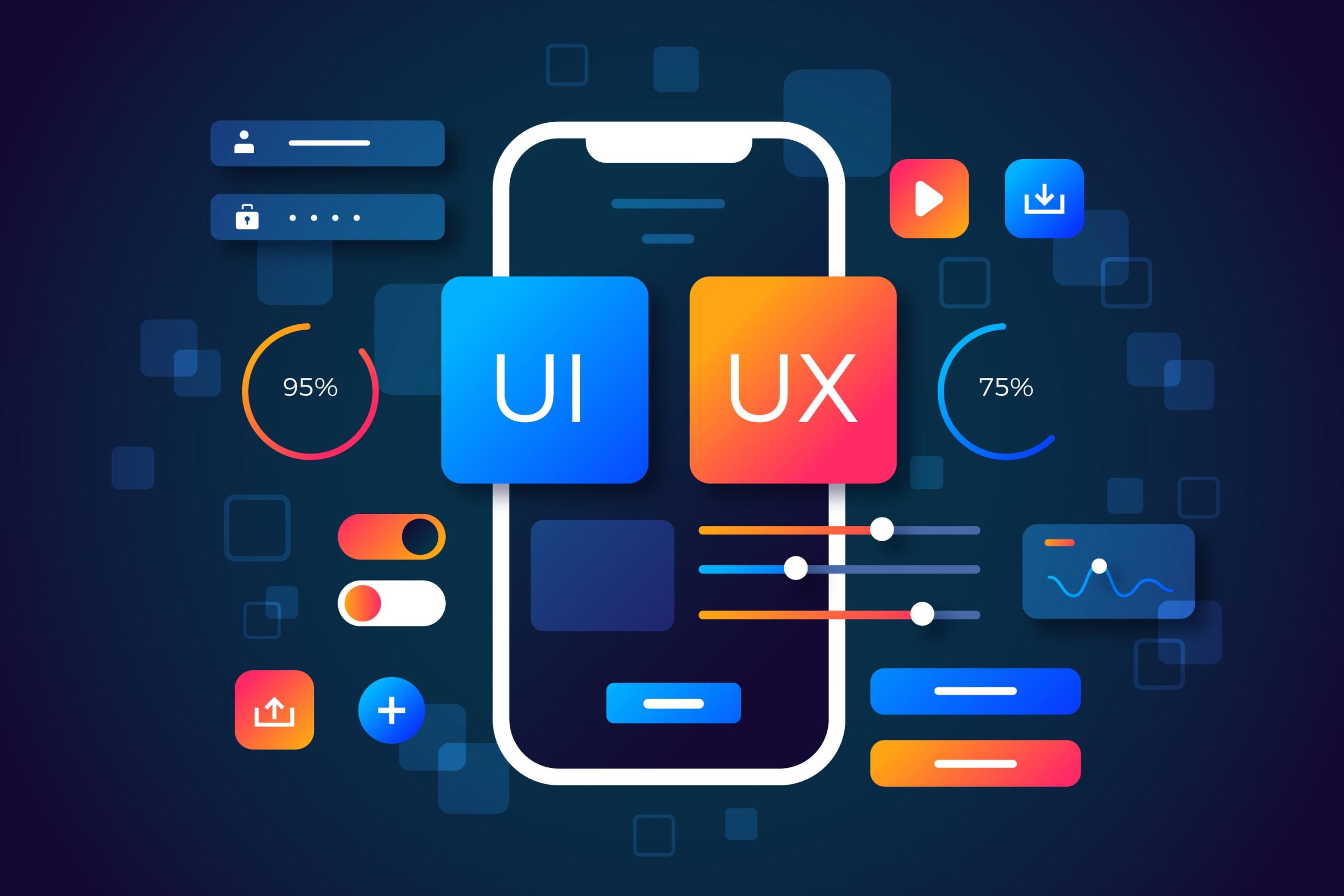User interface (UI) and user experience (UX) design play a crucial role in creating successful websites and Application Development. UI and UX designers are responsible for creating visually appealing and user-friendly interfaces that enhance the overall user experience. If you are passionate about design and technology, becoming a UI and UX web designer could be a fulfilling and rewarding career path. Know the Essential steps and skills required to become a skilled UI and UX web designer.
What is UI in Website Designing and Development?
UI stands for User Interface. It refers to the graphical layout of a website or web application. This includes everything that the user interacts with directly, such as buttons, text, images, sliders, text entry fields, and even the layout and typography. The UI of a website is extremely important because it directly influences how easily users can accomplish their intended tasks on the website. This is why UI design is a crucial aspect of web design and development.
What is UX in Web Designing?
UX, or User Experience, in web designing, refers to the overall experience a user has while interacting with a website or web application. It’s about how easy or pleasant the website is to use, with the aim to provide a seamless, efficient, and satisfying user experience. UX design involves understanding the user’s needs and expectations, then designing the website in a way that meets or exceeds those expectations.
Why does UI/UX Design Matter?
User Interface (UI) and User Experience (UX) design are the cornerstones of modern web development. The seamless integration of design and functionality ensures that visitors have a delightful experience while interacting with your website. Some key benefits of having a UI/UX designer for your web design company.
Benefits of Having a UI/UX Designer in a Web Designing Agency

1. Enhancing User Experience with Intuitive Designs
One of the primary benefits of hiring a UI/UX designer is their ability to create intuitive and user-friendly interfaces. A well-designed website with clear navigation and easy-to-understand layouts enhances user experience, leading to longer visit durations and higher engagement.
2. Driving User Engagement and Interaction
A skilled UI/UX designer can implement interactive elements that captivate users, encouraging them to explore your website further. Engaged visitors are more likely to convert into customers and promote your brand through positive word-of-mouth.
3. Boosting Brand Credibility and Trust
A visually appealing and professionally designed website fosters trust and credibility in the eyes of your audience. A UI/UX designer can ensure your website conveys a strong brand identity and fosters a positive impression of your business.
4. Improving Website Accessibility
An inclusive web design that considers all users, including those with disabilities, is essential in today’s digital landscape. A UI/UX designer can optimize your website’s accessibility, making it compliant with industry standards and regulations.
5. Enhancing Mobile User Experience
With the increasing use of mobile devices, responsive web design has become a necessity. A UI/UX designer can create a seamless mobile experience, ensuring your website is accessible and functional across various screen sizes.
6. Increasing Conversion Rates
A well-designed user interface guides visitors through the conversion funnel smoothly. By optimizing the user experience, a UI/UX designer can increase conversion rates and drive more sales for your business.
7. Gaining a Competitive Advantage
In a crowded digital market, having a unique and visually stunning website can set your business apart from the competition. A UI/UX designer can help you create a distinct online presence that attracts and retains customers.
8. Reducing Bounce Rates
A poorly designed website with confusing navigation often leads to high bounce rates, as users quickly abandon frustrating experiences. A UI/UX designer can analyze user behavior and make data-driven design decisions to reduce bounce rates.
9. Improving SEO Rankings
User experience is an important factor in search engine rankings. A well-designed website with low bounce rates and high user engagement is more likely to rank higher on search engine results pages (SERPs).
10. Fostering Customer Loyalty
A positive user experience fosters customer loyalty and encourages repeat visits. When users have a pleasant interaction with your website, they are more likely to become loyal brand advocates.
The Role of UI/UX in Web Design

The field of UI/UX design encompasses various aspects that contribute to the overall success of a website. Some key roles that UI/UX designers in web design.
1. Conducting User Research
UI/UX designers begin by understanding the target audience through extensive user research. This involves analyzing user behavior, preferences, pain points and needs to create designs that resonate with the audience.
2. Creating Wireframes and Prototypes
Before diving into visual design, UI/UX designers create wireframes and prototypes. These early-stage representations help stakeholders visualize the website’s layout and interactions, allowing for feedback and refinement.
3. Crafting Visual Designs
Once the wireframes are approved, UI/UX designers move on to the visual design phase. They select color schemes, typography, and imagery that align with the brand and create an aesthetically pleasing website.
4. Implementing Responsive Design
In the mobile-first era, UI/UX designers prioritize responsive design. They ensure that the website adapts seamlessly to different devices, screen sizes, and orientations.
5. Collaborating with Developers
UI/UX designers work closely with web developers to implement their designs. This collaboration ensures that the final product aligns with the intended user experience.
6. Conducting Usability Testing
After the website is developed, UI/UX designers conduct usability testing to identify any issues and gather user feedback. This iterative process allows for continuous improvement and optimization.
How to Become a Successful UI/UX Web Designer

UI design focuses on the visual elements of a website or application, such as layout, colors, typography, and icons. On the other hand, UX design centers around the overall user experience, including usability, accessibility, and user interactions. Familiarize yourself with these principles to lay a strong foundation for your career as a UI and UX web designer.
1. Learn Design Software
To excel in UI and UX design, you must become proficient in various design software tools. Adobe XD, Sketch, Figma, and InVision are popular choices among designers. These tools allow you to create prototypes, wireframes, and mockups to visualize your design ideas effectively. Invest time in learning these tools and stay updated with the latest features and trends.
2. Build a Strong Portfolio
A well-crafted portfolio is essential for showcasing your design skills to potential employers or clients. Start building your portfolio by working on personal projects or volunteering for non-profit organizations. Include a diverse range of projects that highlight your versatility as a designer. Your portfolio should demonstrate your problem-solving abilities and how you approach design challenges.
3. Front-End Development
While UI and UX designers are not required to be expert developers, having a basic understanding of front-end development is advantageous. Knowing HTML, CSS, and JavaScript allows you to communicate more effectively with developers and implement your designs with greater precision. It also helps you grasp the technical limitations and possibilities of web design.
4. Stay Updated with Design Trends
The field of UI and UX design is constantly evolving, with new trends and technologies emerging regularly. Stay up-to-date with the latest design trends, best practices, and emerging technologies. Follow design blogs, attend conferences, and join design communities to network with other professionals and gain valuable insights.
5. Seek Feedback and Be Open to Criticism
As you progress in your journey as a UI and UX web designer, seek feedback on your work from peers, mentors, or online communities. Be open to constructive criticism, as it can help you identify areas for improvement and grow as a designer. Embrace a growth mindset and continuously strive to enhance your skills and knowledge.
6. Collaborate with Others
Collaboration is an essential aspect of the design process. Work on projects with other designers, developers, and stakeholders to understand different perspectives and learn from diverse experiences. Effective collaboration enhances the overall quality of your designs and fosters a positive work environment.
7. Emphasize User Research
User research is a critical component of UX design. Conduct surveys, interviews, and usability tests to gather valuable insights about user preferences and behaviors. Understanding your target audience allows you to create designs that cater to their specific needs and expectations.
8. Learn from Case Studies and Real-World Examples
Case studies and real-world examples provide valuable learning opportunities for UI and UX designers. Analyze successful websites and applications, study their design choices, and understand how they addressed specific challenges. Case studies also help you communicate your design decisions effectively when presenting your work to clients or employers.
9. Stay Patient and Persistent
Becoming a skilled UI and UX web designer takes time and effort. Stay patient and persistent throughout your journey, especially during challenging times. Keep practicing, learning, and seeking new opportunities to showcase your skills and grow as a designer.
Conclusion
Becoming a UI and UX web designer is a fulfilling career choice for those with a passion for design and technology. By understanding the principles of UI and UX design, learning relevant software tools, building a strong portfolio, and staying updated with design trends, you can pave your way to success in this ever-evolving field.
FAQs
While coding knowledge is not mandatory, having a basic understanding of front-end development can be beneficial. It helps in effective communication with developers and implementing design ideas accurately.
To improve your UI design skills, practice regularly, seek feedback from peers, and study successful UI designs. Experiment with different layouts, color schemes, and typography to enhance your creativity.
A great UX designer empathizes with users, conducts thorough user research, and creates designs that are intuitive, accessible, and delightful to use. Strong problem-solving and communication skills are also essential.
Include case studies in your portfolio that walk through your design process, from initial research and ideation to the final implementation. Explain your design decisions and demonstrate how you addressed specific challenges.
You can find design communities on platforms like Behance, Dribbble, and LinkedIn. Join online forums and attend design events or meetups to network with other professionals in the field.





































































